Nature’s Alchemy – Petrified Wood
PRIMITIVE - Friday, May 19, 2017By Glen Joffe
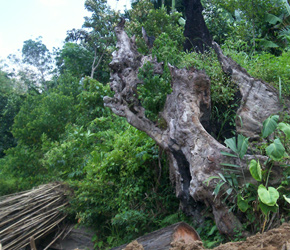 |
|
Photo credit: Glen Joffe |
Imagine walking deep into an isolated forest on the other side of the world. All the noise of modernity is gone. Although nature can be heard; something far different echoes. The stillness of this place feels beyond ancient. Nearby, a stream murmurs. Listening intently, you hear leaves flutter. Some words come to mind; "primordial" is one of them. "Mysterious" and "haunted" also surface. They all seem appropriately descriptive. There is no path where you walk, only a trail barely marked by the faintest of animal prints. Pausing, you strain to remember the history of the earth, a subject you studied in school. How did it go again? First, the earth formed from dust and rocks about four and a half billion years ago. Then, plates formed the crust of the earth about a billion years later. Next, simple cell organisms formed. Then, 535 million years ago evolutionary leaps were made during the Cambrian Explosion, which was followed by multiple mass extinctions. That's about all you can remember, so you start walking, but soon you remember more. Pangaea - a giant land mass formed - one giant super continent that finally split apart to form the modern continents. By the time the first primates evolved, no less humankind, plants had already colonized the planet for 400 million years. In the scheme of evolutionary life, we are a speck of dust, our human ancestors arriving only 200,000 years ago. Trees, you remember, were here long before humankind was even a dream. Suddenly, the ground dips beneath your feet, leading you down a steep incline of packed soil cushioned by vines and fallen leaves. You find yourself at the bottom of a shallow, wide ravine dotted with polished stones. A river must have run through here, but all that's left is the path it forged - a dried overgrown riverbed in a lost world.
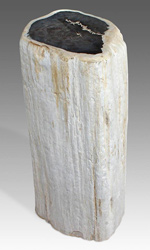 |
|
As you walk in the direction of what you think was downstream, you come across an unexpected sight just around a bend: an ancient tree trunk nestled against the bank of the river. Unlike other logs, this one is not hollow, covered with moss, or freshly fallen even though the wood looks intact and the fine lines of bark are visible. It is half protruding from the ground. In a strange way it looks preserved. Moving closer, you clearly see something is different. Parts of the log appear reflective, polished and veined. Moving even closer you look inside a deep notch, and to your amazement you witness the shimmer of rich red, yellow and green stone. In an instant you are washed with amazement. You have discovered petrified wood - real evidence of life from hundreds of millions of years ago! You run your fingers over this treasure and realize the earth was a vastly different place when this was alive.
The word 'petrify' comes from the Latin term petra, meaning to 'become stone.' While the mythological Medusa can turn anyone who meets her eyes into stone in a matter of seconds, in nature the process takes far longer. This process is known as petrifaction or petrification. It is the process occurring when water that is rich with inorganic minerals passes slowly through organic matter, replacing its cellular structure with the minerals in the water. Some estimates say it takes between ten to several hundred million years or more for wood to turn to stone or more accurately, for wood to fossilize. To put this in perspective, some of the petrified wood we see today grew alongside the dinosaurs; some may be considerably older. In fact, like the dinosaurs, many species of petrified wood are now extinct.
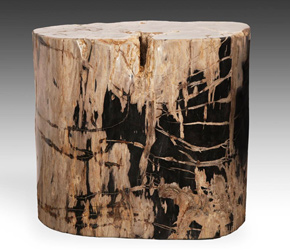 |
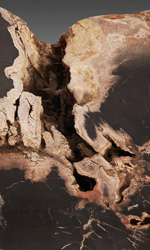 |
|
Petrified wood begins its life by being buried underground or beneath volcanic ash. Deprived of oxygen, the wood is effectively prevented from decomposing in a regular fashion. Instead, over extreme periods of time minerals in earth and water seep into the wood, gradually replacing the organic matter of the wood with silica, or quartz crystals. In essence, these crystals fill in the cells of the wood leaving the original structure intact, and although quartz may be colorless, impurities such as carbon, copper, iron and manganese oxides produce the saturated colors that can be encountered in petrified wood.
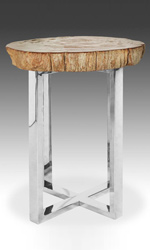 |
|
One of the most beautiful aspects of petrified wood is the preservation of its original form, down to extreme microscopic details such as tree rings and cellular structures. Although technically called fossilized wood, unlike many fossils petrified wood is a complete representation of the tree's natural shape as opposed to a partial impression or fragment of the original organism; for example, the impression of a leaf or a skeleton. No one who sees petrified wood can think of it as 'just wood' – especially if you've tried lifting one! In Indonesia, where much of PRIMITIVE's collection originated, it takes construction cranes and massive tractors to haul the petrified wood from where it is found. Some of the pieces are monumental in size: ancient roots three to four times the height of grown men and trunks almost the length of a football field. Many are simply cleaned and polished, admired as natural sculptures, the handiwork of the artist known as nature. Others are sliced with diamond-tipped saws and hand-polished to be made into one-of-a-kind stools, side tables and tabletops for contemporary interiors. You might say it took millions of years for petrified wood to be created by nature, but only an instant for it to be recognized as high design.
The appreciation of natural art forms has been a long-standing tradition in the East, but it is only in recent decades that Western designers and collectors have embraced this collecting category. As modern lifestyles have become increasingly urban, it appears more and more people are feeling the desire to reconnect with nature in their lives and homes. As a result, petrified wood is now considered a collectible, and because it is a scarce commodity worldwide its value is increasing. Crafted and preserved by the hand of nature, pieces of petrified wood can be evocative and inspiring. Each piece seems to carry with it the history of the natural world and all that it implies. Place your hand on a piece of petrified wood and let it engage your imagination. You will be instantly filled with wonder. The entire history of mankind is a fleeting moment in the life of the object beneath your fingers. It is nature’s alchemy.
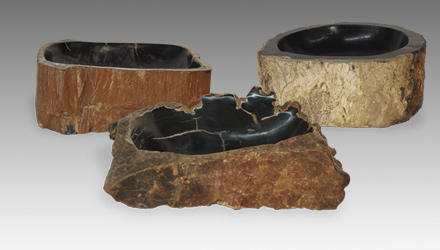 |
Download this Article: Nature’s Alchemy - Petrified Wood.pdf